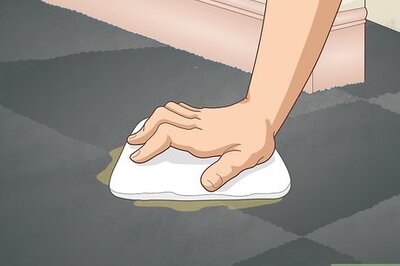
views
For a majority of us who spend our day tethered to chairs, – be it at work, at home, in cafes or anywhere else, there is some bad news from health researchers. In 2017, a study of 7,985 adults in America found that participants who spent most of their waking hours sitting down were more likely to die during the following four-year period.
Interestingly, the concept of sitting down while working wasn’t that common in our lives until a couple of centuries ago. While at the start of the 19th century, there were just one per cent of people who sat down for a living, today three quarters of us work in offices and sit most of our working day. In fact, chairs with a back rest weren’t common until the Industrial Revolution, since most people had stools or sat on the floor. Sitting on the floor or on stools meant that you have to use your back muscles constantly in order to support yourself.
Today, of course, the picture is entirely different. People sit for very long hours while working. Professionals in Mumbai, India’s business capital, are known to work the longest hours, clocking more than 10 hours a day. This means they usually sit for 10 hours a day!
Sitting for a major part of the day has detrimental effect on our posture and increases the likelihood of getting back pain.
The need to stand up
Some studies show that prolonged sitting, for anything from 30 minutes to 12 hours, can be bad for health. This is because most of us tend to hunch over our chairs peering at computer screens. This puts uneven pressure on the spine and tends to shrink the chest cavity. Additionally, fat is not burnt half as fast when you are sitting as it is when you move. So, it is recommended to take a five to 10-minute break every hour of continuous screen use.
Of course, many may point out that our jobs today require us to sit down. Most jobs do not involve physical activity which means we have to make a special effort to exercise. Several studies, such as an ICMR-INDIAB, have found that a large percentage of people in India are inactive, with fewer than 10% engaging in recreational physical activity. This has led to an increase of type 2 diabetes and cardiovascular diseases in the country.
The ‘exercise’ element
There is enough evidence about the importance of exercise in our lives. A study of sedentary behaviour of 150,000 Australian adults by the University of Sydney, Australia and Loughborough University in the UK, found that premature mortality and cardiovascular disease was an issue in the least physically active groups – those who were putting in less than 150 minutes of exercise a week. However, some scientists found that irrespective of exercise habits, the risk of death grew in line with total sitting time for durations in excess of 30 minutes.
The relation between sitting and health and safety
In the UK, the Health and Safety at Work Act 1974 and the Management of Health and Safety at Work Regulations 1999 require employers to protect their employees from risks to their health, which would include sedentary work.
In February this year, the Health and Safety Executive (HSE), a UK government agency, commissioned the Workplace Health Expert Committee (WHEC), which advises it on emerging risks, to provide scientific evidence that could inform its policy around sedentary working. The WHEC found that people who sit for long periods are at greater risks of cardiovascular disease, type 2 diabetes, colon, endometrial, lung and breast cancers and depression.
What to do then?
According to the HSE, approximately 507,000 workers have experienced work-related musculoskeletal disorders. This means that it is now more important than ever for employers to intervene if they want their workforce to remain fit. Companies need to advise staff that prolonged sitting may significantly increase the risk of cardiometabolic diseases and premature mortality. In some countries, sit–stand (or stand–up) desks are coming in as a solution for integrating more movement and standing into the office environment. These adjustable sit-stand desks allow workers to alter the height and work while sitting down or standing up as required.
However, not all health experts are happy with them. Professor Karen Walker-Bone is director at Arthritis Research UK/MRC centre for Musculoskeletal Health and Work. She says it is true that prolonged sitting puts pressures on the discs in the back. However, pressure levels have not been shown to be any higher compared to prolonged standing. She considers the static posture to be a danger, whichever one – sitting or standing!
Some organisations in the UK like the Lambeth Council are using a new ‘hot-desk’ set up in their offices. This has meant that employees are moving regularly to different desks and unfamiliar set-ups. The equipment is flexible with fully adjustable chairs and PCs on movable arms. However, staff is “often found to forget to make the adjustments they need to work comfortably”. The Council is handling the issue proactively. They are constantly educating their employees about the need to adopt good posture and take regular breaks.
Whether you invest in a sit-stand desk or decide to take the stairs when possible, we should remember that our bodies need exercise. They are meant to move and that is what we should all be doing rather than lounging in our chairs for hours on end!



















Comments
0 comment